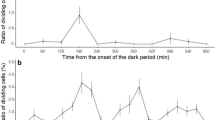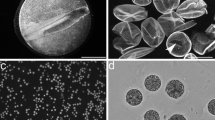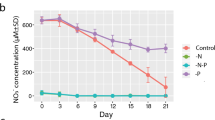Abstract
The time course of DNA synthesis in developing haploid gametophytes of the giant kelp Macrocystis pyrifera was determined, and the effects of arsenic (As) on the temporally distinct nuclear events, DNA synthesis and subsequent nuclear division/translocation, were investigated to establish which of these specific events may be disrupted by this contaminant. Experiments were carried out on material collected from kelp beds near Santa Barbara, California from 1993–1994. Timing of DNA synthesis was determined during development by use of the fluorochrome, DAPI (4′,6-diamidino-2-phenylindole), and single-cell microspectrofluorometry. Zoospores, which result from meiosis, had already undergone two rounds of DNA synthesis at the time of release. The developing gametophytes underwent an additional two rounds of replication of DNA by 16 h of development, and following the first nuclear division/translocation, the gametophyte contained eight times the minimum DNA level throughout subsequent development. Both DNA synthesis and nuclear division/translocation, were found to be inhibited by As. Phosphate enrichment reduced the inhibitory effects of As on division/translocation of the nucleus, supporting the hypothesis that As interferes with phosphorylation. Gametophytes were more severely affected by As under light conditions, as opposed to dark, suggesting that photosynthesis may be more sensitive than dark metabolism.
Similar content being viewed by others
References
Amsler CD, Neushul M (1991) Photosynthetic physiology and chemical composition of spores of the kelps, Macrocystis pyrifera, Nereocystis leutkeanan, Laminaria farlowii, and Pterygophora californica (Phaeophyceae). J Phycol 27:26–34
Andreae MO, Klumpp D (1979) Biosynthesis and release of organoarsenic compounds by marine algae. Envir Sci Technol 13: 738–741
Anderson BS, Hunt JW (1988) Bioassay methods for evaluating toxicity using Macrocystis pyrifera. Mar envirol Res 26:113–134
Anderson BS, Hunt JW, Turpen SL, Coulon AR, Martin M (1990) Copper toxicity to microscopic stages of giant kelp Macrocystis pyrifera: interpopulation comparisons and temporal variability. Mar Ecol Prog Ser 68:147–156
Avron M, Jagendorf AJ (1959) Evidence concerning the mechanism of ATP formation by spinach chloroplasts. J biol Chem 234: 967–972
Brzezinski MA, Reed DC, Amsler CD (1993) Neutral lipids as major storage products in the zoospores of the giant kelp Macrocystis pyrifera (Phaeophyceae). J Phycol 29:16–23
Chou IN (1989) Distinct cytoskeletal injuries induced by As, Cd. Co, Cr, and Ni compounds. Biomed envirl Sciences 2:358–365
Clark RB (1989) Marine pollution. 2nd edn. Clarendon Press, Oxford, England
Cole K (1968) Gametophytic development and fertilization in Macrocystis integrifolia. Can J Bot 46:777–782
Debec A, Courgeon AM, Maingourd M, Maisonhaute C (1990) The response of the centrosome to heat shock and related stresses in a Drosophilia cell line. J Cell Sci 96:403–412
Gall J (1981) Chromosome structure and the C-value paradox. J Cell Biol 91:35–145
Garman GD, Pillai MC, Cherr GN (1994) Inhibition of cellular events during algal gametophyte development: effects of select metals and an aqucous petroleum waste. Aquat Toxic 28:127–144
Goff LJ, Coleman AW (1984) Elucidation of fertilization and development in a red alga by quantitative DNA microspectrofluorometry. Devl Biol 102:173–194
Goff LJ, Coleman AW (1990) DNA: microspectrofluorometric studies. In: Cole KM, Sheath RC (eds) Biology of the red algae. Cambridge University Press, New York, pp 43–71
Goyer RA (1986) Toxic effects of metals. In: Klaassen CD, Amdur MO, Doull J (eds) Casarett and Doull's toxicology. MacMillan Co, New York, pp 582–635
Haig D (1993) Alternatives to meiosis: the unusual genetics of red algae, microsporidia, and others. J theor Biol 163:15–31
Hopkin R, Kain JM (1978) The effects of some pollutants on the survival, growth, and respiration of Laminaria hyperborea. Estuar estl mar Sci 7:531–553
Jung C, Rothstein A (1965) Arsenate uptake and release in relation to the inhibition of transport and glycolysis in yeast. Biochem Pharmae 14:1093–1112
Kremer BP, Markham JW (1979) Carbon assimilation by different developmental stages of Laminaria saccharina. Planta 144:497–501
Li W, Chou IN (1992) Effects of sodium arsenite on the cytoskeleton and cellular glutathione levels in cultured cells. Toxic appl Pharmac 114:132–139
Lüning K (1980) Critical levels of light and temperature regulating the gametogenesis of three Laminaria species (Phaeophyceae). J Phycol 16:1–15
Lüning K, Neushul M (1978) Light and temperature demands for growth and reproduction of laminarian gametophytes in southern and central California. Mar Biol 45:297–309
Markham JW, Kremer BP, Sperling KR (1980) Effects of cadmium on Laminaria saccharina in culture. Mar Ecol Prog Ser 3:31–39
Mitchell RA, Chang BF, Huang CH, DeMaster EG (1971) Inhibition of mitochondrial energy-linked functions by arsenate. Evidence for a non-hydrolytic mode of inhibitor action. Biochemistry, Easton, Pa 10:2049–2054
Pillai MC, Baldwin J, Cherr GN (1992a) Early development in an algal gametophyte: regulation of germination and nuclear events by cytoskeletal elements. Protoplasma 170:34–45
Pillai MC, Garman GD, Goff LJ, Cherr GN (1992b) Nuclear events during early gametophytic development in a brown alga. Molec Biol Cell 3:p. 18a
Planas D, Healy FP (1978) Effects of arsenate on growth and phosphorus metabolism of phytoplankton. J Phycol 14:337–341
Provasoli L (1968) Media and prospects for the cultivation of marine algae. In: Watanabe A, Hattori A (eds) Cultures and collections of algae. Japanese Society of Plant Physiology, Hakone, pp 63–75
Reed D, Neushul M, Ebling AW (1991) Role of settlement diversity on gametophyte growth and reproduction in the kelp, Macrocystis pyrifera. J Phycol 27:361–366
Rothstein A (1963) Interactions of arsenate with the phosphate transporting system of yeast. J gen Physiol 46:1075–1085
Sanders JG (1979) Effects of As speciation and phosphate concentration on arsenic inhibition of Skeletonema costatum (Bacillariophyceae). J Phycol 15:424–428
Sanders JG, Windom HL (1980) The uptake and reduction of arsenic species by marine algae. Estuar cstl mar Sci 10:555–567
Sandoval F, Gomez-Puyou A, Tuena M, Chavez E, Pena A (1970) Effect of sodium and potassium ions on mitochondrial oxidative phosphorylation. Studies with arsenate. Biochemistry, Easton, Pa 9:684–689
Scarborough G (1975) The mechanism of arsenate inhibition of the glucose active transport system in Neurospora crassa. Archs Biochem Biophys 166:245–250
Sibatani A (1959) In vitro incorporation of 32P into nucleic acids of lymphatic cells. Expl Cell Res 17:131–143
Stubblefield E (1975) Analysis of the replication pattern of Chinese hamster chromosomes using 5-bromo-deoxyuridine supression of 33258 Hoechst fluorescence. Chromosoma 53:209–221
Takahashi A, Kawakami H, Bada A, Okonogi Y, Matsuto S (1990) Effects of phosphate on arsenate inhibition in a marine cyanobacterium, Phormidium sp. Appl organometall Chemy 4:269–279
Thursby GB, Steele RL (1984) Toxicity of arsenite and arsenate to the marine microalga Champia parvula (Rhodophyta). Envir Toxic Chem 3:391–397
Wordeman L, Cande WZ (1987) Reactivation of spindle elongation in vitro is correlated with the phosphorylation of a 205 kd spindle-associated protein. Cell 50:535–543
Zar JH (1974) Biostatistical analysis. Prentice-Hall, Inc., Englewood Cliffs, New Jersey
Author information
Authors and Affiliations
Additional information
Communicated by M. F. Strathmann, Friday Harbor
Rights and permissions
About this article
Cite this article
Garman, G.D., Pillai, M.C., Goff, L.J. et al. Nuclear events during early development in gametophytes of Macrocystis pyrifera, and the temporal effects of a marine contaminant. Marine Biology 121, 355–362 (1994). https://doi.org/10.1007/BF00346745
Received:
Accepted:
Issue Date:
DOI: https://doi.org/10.1007/BF00346745




